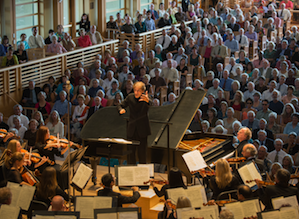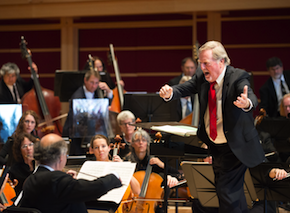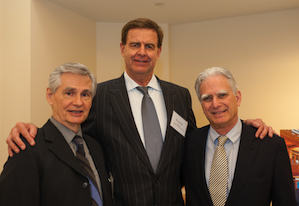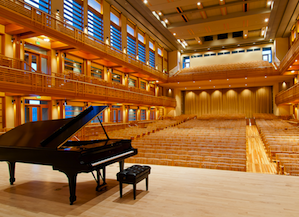
The Joan and Sanford I. Weill Hall, the dazzling 1,400-seat heart of Sonoma State University's $130 million Donald & Maureen Green Music Center opened this weekend with two festive and soldout performances. On Saturday, it was a recital by Lang Lang; Sunday afternoon, the hall's resident orchestra made its debut.
Santa Rosa Symphony was conducted by Music Director Bruno Ferrandis, featuring his predecessor, Jeffrey Kahane as piano soloist, and former Music Director Corrick Brown in the opening Beethoven Consecration of the House Overture.
There is no question about the hall's appearance: it's all light-colored wood, with light pouring through the windows (silent air conditioning battling the 90-degree heat successfully), airy, graceful — an elegant, appealing structure, giving "barn" a good name. The windows make Weill Hall look even better than its architectural twin, Tanglewood's Seiji Ozawa Hall.

Both venues, by architect William Rawn Associates and acoustician Lawrence Kirkegaard, feature a back wall that opens up, allowing hundreds of additional listeners on the lawn. Saturday night and Sunday afternoon, the free attendance there attracted more than a thousand people on each occasion.
And now, to the matter of acoustics. I did not attend the Lang Lang recital, but heard a piano in an empty Weill Hall before — and it was stunning. Listening while walking around, the sound appeared clear and rich from every spot. On Sunday, listening from one place in the center of the orchestra section, with 1,400 bodies absorbing the sound, and the back wall open, the experience was different.
The good: The sound appears from a single source, without echoes; reverberation time seems exactly right. The problem: Instruments upstage — low strings, woodwinds, brass — sound somewhat mushy, veiled. Those familiar with Disney Hall's clear, (over)bright acoustics would understand what is meant by calling Weill Hall the opposite.

Violins downstage on either side of the conductor, and the piano in the concerto, were better. Until the San Francisco Symphony and other orchestras play in the hall, it's difficult to say how much of that sound differential was a matter of acoustics or what role the Santa Rosa Symphony had in it.
Brown conducted the opening National Anthem and the Beethoven overture, the orchestra still warming up, but both violin sections in full bloom. Ferrandis took the baton for Beethoven's Piano Concerto No. 4, with Kahane at the keyboard. Balances picked up, tempos were consistent, the solo performance varied. There was something excessively blustery at times in Kahane's performance in the Allegro and Rondo, but the Andante worked well, and both cadenzas — while a bit on the loud side — were virtuosic, clear, and expressive.
Nolan Gasser's brief Sonoma Overture for Orchestra, a commissioned work, had its premiere. The 10-minute overture from a well-known Petaluma composer, impressed with its complex and effective orchestration, but did not leave a lasting memory.

The Santa Rosa Symphony Honor Choir, Sonoma Bach Choir, Montgomery High School, and Santa Rosa High School Chamber Singers contributed to Copland's gnarly, rarely-performed Canticle of Freedom. Lack of clear diction and the acoustics from the choral platform above the orchestra made the 14th-century text impossible to understand. (Copland used John Barbour's 1395 poem about the value of freedom.)
Saving the best for last, Ferrandis and the orchestra — as an ensemble and featuring brief solos by numerous instruments — shone in Ravel's Boléro, rushing inexorably into that mighty finale.
In addition to Weill Hall, the center also includes:
- The Music Education Hall, of seminar rooms, ensemble/rehearsal rooms, practice studios, musical activities rooms, faculty and administrative offices
- The 250-seat Schroeder's Recital Hall, planned with a high ceiling and curved walls, serving choral music, but also accommodate classes
- Prelude: a special event, wedding and meeting facility, with an exterior patio, featuring pools, fire pits, and an arbor overhead.
